 Research Article
Research Article
Knowledge of Ethnobotany as Traditional Medicine Muna Community in West Muna Regency
Rahmat Sewa Suraya*, Hardin, La Ode Muhammad Sardin, Agus Rihu and La Ode Muhammad Detif Rahim
Department of Oral Tradition, Faculty of Cultural Sciences, Halu Oleo University, Indonesia
Rahmat Sewa Suraya, Department of Oral Tradition, Faculty of Cultural Sciences, Halu Oleo University, Indonesia.
Received Date:September 14, 2023; Published Date:December 05, 2023
Abstract
Ethnobotany as a traditional medicine of the Muna people in West Muna Regency is very little known by the community and is usually only passed down from generation to generation and is difficult to convey freely. Therefore, the purpose of this study is to describe and explain the use of ethnobotany/ plants as traditional medicine in millennial communities and procedures for processing and utilization of plants in traditional medicine of the Muna community in West Muna Regency. The results of this study found that 1) The types of plants used by the Muna community as traditional medicine materials obtained in the study there were 30 types of plants, namely ntanga - ntanga (castor), bumalaka (guava), sambiloto (sambiloto), tongkoea (pulai), gamala (gamal), padamalala (lemongrass), lakora (jukut Peendul), kansilala, kapati - pati (petikan kebo), kamena - mena (miss flower), katola, broken glass and cat whiskers, libho (awar-awar), gersen (gerseni), bulumembe (sadugari), kabu - kaburu, kadhawa (Kapuk/randu), katabha-tabhako (sembung), puno (ruku-ruku), loghi (ginger), kuni (turmeric), patiwala (tembelakan), kalima-lamano tooke (panabelut),kambo-mbote (ciplukan), bhanggai (moringa), komba–Komba (Tekelan), Radhawali (Brotawali), Sirikaea (Sirikaya), Saha (Chili), Kapaeaa (Papaya) and Mangkudu (Noni) 2) Procedures for processing and utilizing plants as traditional medicine are carried out in several ways, namely by boiling and drinking, pounding and then smearing/pasting, shredding and drunk, chewing then blowing, cutting and dripping. However, Muna people more often use potions by boiling and then drinking to patients or sick people. Then, the benefits of plants in traditional medicine are to treat high blood pressure, to treat reduce pain in organs, to heal one wound, to treat asthma, to treat dangerous diseases, to treat fever, to treat external wounds, treat diarrhea, to treat trachoma, to treat itching in the skin and so on.
Keywords: Etnobotani; traditional medicine; Etnomedicine
Introduction
In the midst of modern medical treatment that continues to experience very rapid development, treatment through traditional methods still shows its existence. Traditional medicine refers to the effort to treat a disease through local knowledge as well as knowledge that is not included in modern medicine owned by the community. Traditional knowledge concerns local wisdom, traditional ecology, indigenous knowledge, shamanism and traditional knowledge. Traditional knowledge from generation to generation develops dynamically, blending with community identity so that it becomes the cultural heritage of the community that owns it [1].
Ethnobotany is one branch of ethnobiology that studies the concepts of community knowledge about plants which are the re sult of the cultural development of a society [2]. Based on observations carried out in the Muna Community, most people use plants for traditional medicine. In the use of medicinal plants in general, it is done in two ways, namely directly and use by concocting. Directly such as skin diseases, and headaches, usually by tying, smearing / rubbing, and washing. Direct use of masks of certain plant types without having to be mixed first can be consumed immediately. As plants that are commonly used directly, namely leaves, fruits, fruit water, sticks, buds, and midribs. Like komba-komba leaves that are milked and then attached to a person’s wound.
Use by concocting means that plants used as medicine are
mixed first through a simple process, for example, areca nut beard
to treat goiter, areca nut beard added with nutmeg mixed with castor
sap pounded and then applied to the sore spot. This is reinforced
by research conducted by [3] that medicinal plants are all
species of medicinal plants that are known or believed to have
medicinal properties. Medicinal plants are grouped into 3 groups,
namely:
I. Traditional medicinal plants, namely plant species that are
known or believed by the public to have medicinal properties
and have been used as raw materials for traditional medicine,
II. Modern medicinal plants, namely plant species that contain
bioactive compounds/ingredients that have medicinal properties
and have been scientifically proven and their use can be
medically accounted for.
III. Potential medicinal plants, namely plant species that are
thought to contain bioactive compounds/ingredients that have
medicinal properties, but have not been proven scientifically
and medically, or in other words their use as traditional medicine
ingredients is difficult to trace.
The advantage of treatment using traditional plant ingredients is the minimal side effects caused compared to those that often occur in chemical treatment [4]. In addition, plants used in traditional medicine are very easy to find in the surrounding environment because some people because most people cultivate them. Besides being used as an ingredient for medicine, the plant can be used for cooking ingredients. Knowledge of medicinal plants themselves is closely related to the conditions of the surrounding environment. The closeness of the community to alam, greatly affects the knowledge of plants that can be used as medicinal materials.
Drug processing is carried out in various ways, namely, boiled, ground, grated, and cooked. The processing is done most by boiling and pounding, because generally the community concocts these medicinal plants in the form of herbs, while the least processing is done by cooking and grating. Because according to the community, the processing of herbs by boiling and pounding is more effective in curing the diseases they experience. Knowledge about the processing of medicinal plants in the community is very minimal so that plants that have the potential as medicine around the yard are rarely used optimally [5]. So that the community needs someone who knows more about how to process medicinal plants, namely by going to a man to ask for herbs or to cure the disease he is experiencing. In addition to the lack of public knowledge about the benefits of plants in processing into medicine , the community is also very minimal knowledge about various types of plants or medicinal plants that can be used as medicine.
Research Methods
The method used in this studyis a descriptive qualitative method because this research focuses on knowing the study of ethnobotany/ plant knowledge of Muna in Lawa District by describing the data obtained related to how the community utilizes natural resources around. The research with qualitative methods aims to obtain a complete picture of something according to the human view studied. Qualitative research deals with the ideas, perceptions opinions, or beliefs of the person under study; all of them cannot be measured by numbers (Sulistyo-Basuki, 2006). In sampling the required data sources, it is carried out by purposive sampling techniques. According to Sugiyono (2008) this sampling technique is often used in qualitative research, where sampling data sources with certain considerations such as someone who is considered to have more knowledge about what we expect in conducting research [6]. The sampling technique was carried out with structured interviews aimed at gaining community knowledge about plant, animal and environmental management as an ethnobotanical study of the Muna community in Lawa District.
Results and discussion
Identification of plants as traditional medicine
Health is something fundamental to life and a fundamental problem for humans. Throughout the history of human civilization, plants, and public health are two things that are deeply related to human life. Various types of plants have been used for a long time to solve health-related problems, improve health, and maintain the immune system of the human body. Today, when the demand to live in harmony with nature is increasing, the use of plants as an essential material in human health is getting more and more attention. Plant processing is one of the medicines of local wisdom that is still maintained in the Muna community in the Lawa District. Ethnic knowledge provides benefits in terms of health and economics because the materials are easy to obtain with simple processing without the need for modern equipment
The use of plants for medicinal purposes has been done by humans since antiquity. In Indonesia, this utilization can also be found in various regions, especially in Muna Barat, Lawa District, with the level of diversity of species used, composition, and characteristics offered [7]. The study of ethnobotanical knowledge of the community pays much attention to certain types that are consumed as a form of utilization of plants for human health. Utilization can be applied consumptively and for external use. Each community group in the Lawa sub-district has a unique way of defending themselves against disease. This knowledge develops freely by word of mouth and can be obtained through the source of traditional herb books. This is the basic reference for developing an understanding of the use of ethnobotany in the community of Lawa District, Muna Regency.
The use of these plants provides more knowledge about the types of plants used for medicine, especially in preventing or treating diseases in the Lawa community, West Muna Regency [8]. There are several types of community knowledge by relying on ethnobotanical knowledge in the community including; (1) Ntanga – Ntanga (Distance) / Ricinus communis; (2) Bumalaka (Guava) / Psidium guajava; (3) Sambiloto (Sambiloto) / Andrographis paniculata; (4) Tongkoea (Island) / Alstonia scholaris; (5) Gamala (Gamal) / Gliricidia sepium; (6) Padamalala (Lemongrass) / Cymbopogon citratus; (7) Lakora (Jukut Peendul) / Kyllinga brevifolia; (9) Kansilala (Pulutan) / Urena Lobata; (10) Kapati – Pati (Kebo Citation)/ Euphorbia hirta; (11) Kamena – Mena (Miss Flower) / Clerodendrum thomsonae Balff; (12) Katola/Arcangelisia flava L; (13) Shard rupture (Strobilanthes crispus); (14) Cat’s Whiskers (Orthosiphon aristatus); (15) Libho (wars) / Ficus septica; (16) Kersen (Gerseni) / Muntingia calabura; (17) Kabulumembe (Sidaguri) / Sida rhombifolia L.; (18) Kabu – Kaburu; (19) Kadhawa (Kapuk/Randu) / Ceiba pentandra;( 20) Katabha-tabhako (sembung) / Blumea Balsamifera; (21) Puno (Ruku-Ruku) / Ocimum tenuiflorum; (22) Loghi (Ginger) / Zingiber officinale; (23) Turmeric / Curcuma longa; (24) Patiwala (Tembelakan)/Lantana camara; (25) Kalima-lamano tooke (panabelut) / Trichosanthes; (26) Kambo-mbote (Ciplukan) / Physalis;(27)Bhanggai (Moringa) / Moringa oleifera; (28) Komba – Komba (Tekelan) / Chromolaena odorata; (29) Saha ( Chili) / Capsicum frutescens; (30) Kapaea (Papaya) / Carica Papaya; (31) Mangkudu (noni) / Morinda citrifolia
Processing and Utilization of Plants as Traditional Medicine
The process of taking plants to be used as medicine by the Muna community is inseparable from the spiritual understanding of the local community. Dnature takes plants first to ask permission from the owner of the plant to be taken so that the plants used do not become toxic or harmful when consumed. Taking plants also has adab, which is asking permission from the plant and by reading prayers or mantras so that the plants that will be used are more effective to treat diseases. So, before taking herbs to be used as medicine, first read the following mantra prayer “Karuku bisa lansau bisa (venomous plants, poisonous medicinal plants). The purpose of the chanting of the mantra is to ask the Almighty to always be under His protection when taking medicinal plants and to avoid unwanted bad things and plants taken can cure the treated pain.
Muna people in treating a disease they experience, usually do not immediately go to the hospital or consume drugs, but they use plants that are around or in their environment to be used as medicine in a simple way of processing [9]. The processing procedure, usually done by boiling, grating, attached to the diseased part. This method of processing is known based on information obtained from parents from generation to generation and personal experiences of the community itself. The procedures for processing and utilizing each plant can be explained in the section below.

The ntanga-ntanga plant above is one type of plant that is easily found by the community. This plant is commonly planted and grows around the house. The community deliberately planted castor leaf plants because it is considered a traditional medicine. The plant has a rather viscous gummy stem. Leaves wide, heart-shaped, flat or slightly notched edges and long peduncles. Flowers yellowish- green, unisexual, monoemacy. Both male and female flowers are each arranged in a series in the form of a saucer. Ovoid-shaped fruit, divided into three chambers, does not bloom. This plant can treat several diseases including ulcers and blood urine. How to use, take a few leaves then boil and drink the water. Therefore, this plant is easily obtained in the yard of the Muna community because of its effectiveness in treating diseases.
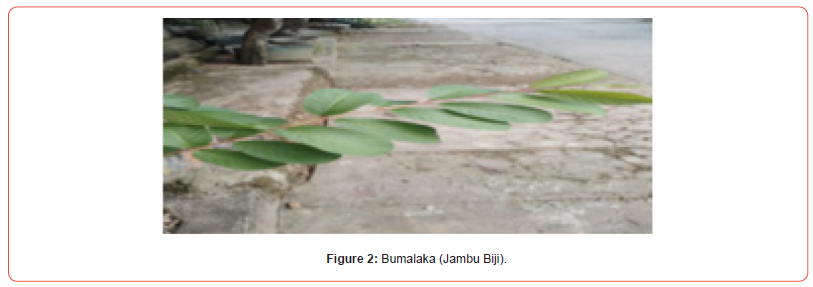
The bomalaka plant above is one type of medicinal plant that has many benefits to cure diseases. Muna people usually use this plant to treat diseases they experience such as diabetes, diarrhea, dengue fever, burns, sore throat, and so on. How to process and use it is done with bamalaka ingredients washed thoroughly then boiled to boil, cool, and then strain. Boiled water is drunk as much as 1/4 cup while reciting the mantra/prayer below. “Dhari lansau buea, Manasa andi kandi, Nasokapadja aku barakati, Molaha illallah bisimilah, Naso kapadja aku barakati, Molaha illallah bisimila”.
Based on the results of interviews with informants at the research location said that almost all Muna people know that bumalaka leaves can treat stomach pain (diarrhea) both boiled and chewed directly without having to be boiled first. This plant is believed by the Muna community to be beneficial for the health of both leaves and fruits. Guava leaves are useful for treating stomach pain / diarrhea while fruit is useful for juicing or consumed directly. This plant can be found anywhere growing wild in the forest and also planted directly by humans.

The Sambiloto plant above is a type of plant that is easily found because this plant is easy to grow around the yard of the house and in the community garden. This plant is quite famous in the community as an herbal medicine that can treat various diseases. One of the diseases treated with this plant is malaria and diabetes. The trick is to take a few leaves to taste then boil and drink the water morning and night.

Tongkoea tree has a leaf shape similar to frangipani leaves with beautiful yellow flowers, the trunk is straight, woody, and cylindrical, the branching is sympodial, and contains a lot of white sap that tastes very bitter. The Tongkoea tree is also used as an ingredient in the handicraft industry and as an ingredient in the pharmaceutical field because its bark contains alkaloids that can be used as medicine. Therefore, people in West Muna use the leaves to be used as dental medicine by draping the leaves that are still gummy and then stuck or closing on the diseased tooth hole.

Gamala plants are one type of plant that is easily obtained in the community. This plant is commonly used as feed for cattle and goats. This plant is used by the community as a garden fence so that other animals such as pigs and cows can disturb and eat plants. In addition, gamal plants are also used as traditional medicine to treat itchy skin and wounds. How to use it is done by poking until smooth then bandaged or attached to itchy skin or wound sites.

Padamala plant is one type of plant that is commonly used for serving ingredients or cooking spices such as spices in cooking fish, vegetables and so on. In addition, this plant is believed by the community as a traditional medicine to treat various diseases. One of the benefits of Padamala is as a medicine for gout and kidney disease. As for how to process and utilize this plant, it is done by boiling. After boiling, the water is then drunk morning and night [10]. The use of Padamala plants has long been practiced by the Muna community, and until now it is still being used by the community. People use this plant as a kitchen spice, but some people use lemongrass as medicine, some people believe that lemongrass root boiled water can treat high blood pressure. This lemongrass plant also has the benefit of curing tendons/sprains in human organs. The part of this plant that is utilized is the stem. The processing method is to take a few lemongrass sticks, then clean and slice them, or they can also be halved. Then boil enough water to boil, then cool the cooking water, and can be drunk directly

The Lakoora plant above is one type of wild grass plant that interferes with other plants planted by farmers. This plant usually grows in the yard of the house and grows in the garden. This plant is quite disturbing corn, peanuts and other crops when growing in the garden. Therefore, this plant is always cleaned by the community. It’s just that, this plant turns out to be used by some people as traditional medicine. This plant is used by the community to treat internal medicine. The trick, taken to taste then boiled and the water drunk.

The kansilala plant above is one type of wild plant that is easily found in community plantation areas. This plant is commonly used as traditional medicine by the Muna people. One type of disease that can be treated with this plant is nosebleeds. The way of treatment is to take some of the leaves, then cut until smooth and attached around the nose and some of the water is inserted in the nose.

The kapati-kapiti plants above are plants that live creeping on the surface of the soil. This plant is a wild plant that usually grows on the surface of the soil, is not too moist and is commonly found scattered everywhere. This starch kebo plant has many properties to treat various diseases. One of the properties of this plant is that it can cure inflammatory diseases of the kidneys. How to use it, is done by boiling the stems and leaves then filtering and then drinking water as much as one glass.

The kamena-mena plant above is one type of plant that is easily found around river areas and swamp areas. This plant is commonly used as a traditional ritual material in cultivation. Muna people, believe this plant is considered a symbol for plant fertility. This plant also has many benefits for public health even though it grows wild, but according to public belief, a mixture of kamena-mena and ntanga-ntanga (castor) plants that have been mashed can treat and treat ulcers that are difficult to get out and treat wounds in organs. These two plants have many benefits, Miss flowers are used by the community to take pasele (fetobho kahitela), the goal is that all corn plants in the garden bear fruit even though the trees are small [11]. While Jatropha plants, both leaves and sap have many benefits, namely leaves to treat plant pests while sap to reduce tooth pain, canker sores, and cure internal pain (organs) due to sprains / tendons and asthma. In addition, this plant is also believed to be a medicine to cure various diseases. One of them, treating caffeinatory disease (internal medicine). The trick is to take a few kamena-mena leaves then boil until boiling. After boiling it is further filtered and drunk the water.

The katola wood above, isa type of plant that grows wild in certain forest areas. This plant is very difficult to obtain because it grows wild in forest areas and does not grow around people’s residences. To get this katola wood requires extra time and effort because it is rarely found. This plant is very efficacious for treating internal diseases, such as thin defecation accompanied by blood. The trick, patola wood is dried first under the hot sun until the wood is completely dry, then boiled until boiling. After that, the water is drunk twice a day morning and night.

Clear broken plants and cat whiskers are types of flower plants that are commonly planted by people in their respective yards. In every yard of a resident’s house, there are almost always these two types of plants. Besides being used as medicine, this plant is planted to beautify the yard of residents’ homes. The part used for this plant medicine is the leaves. Both leaves of the plant are taken to taste, then ground until smooth, and then attached to itchy skin or wound sites.

The libho plant above is a type of plant that is used as a medicine for diseases in the Muna community. This plant, used to treat caffeinatory disease (internal medicine) experienced by children. This plant, easy to find because it is easy to grow in community gardens. How to process and utilize, can be done by taking some leaves of libho plants and then attaching them to the bodies of children who experience illness
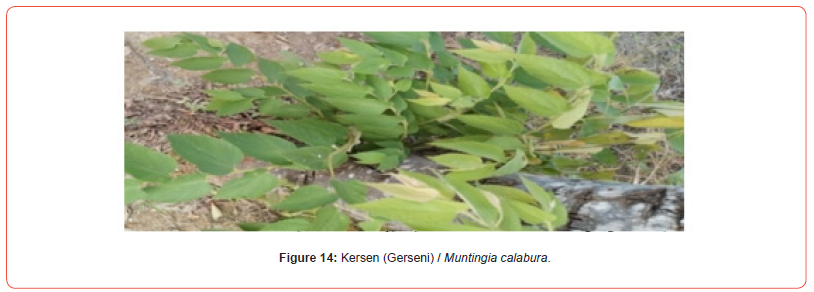
Kersen plant is one plant that has many benefits, including as a protective tree and herbal medicine that is believed to cure various diseases. Kersen leaves have benefits for treating diabetes and other internal diseases. In addition to the leaves, the foam can also be eaten. The processing method is done by boiling the leaves and then drinking morning and night. Each time drink as much as one cup/glass.

Bhulu bhembe plant is a plant that is used to treat nosebleeds suffered by children. The processing is done by kneading, then the water is filtered and inserted in the nose of a sick child. Usually, after treatment like this, sick children do not recover long and recover from illness.

Ka-bu-buru plant is one type of plant that is used to treat various diseases. This plant is commonly used by the community to treat diseases, such as stomach disease. The processing method is to take a few leaves to taste, then boil until boiling. Then, the water is filtered and drunk once a day.
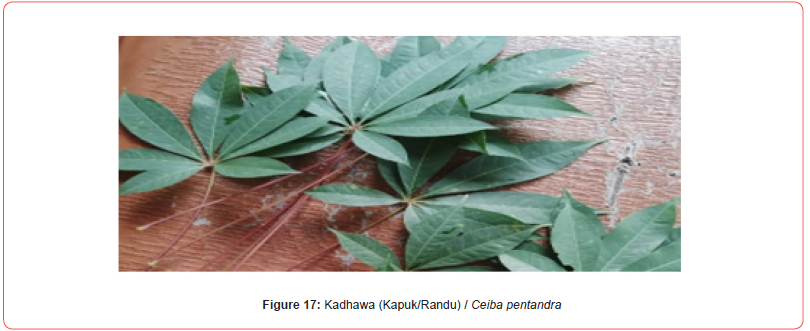
Kadhawa is one type of plant that is easily found in the community. For the people of Muna, kapok fruit can be used as foam/ contents of pillows and bed mattresses. In addition, Kadhawa can also treat a fever that never heals. The trick is kapok leaves (Ceiba Petandra) and sandalwood leaves are soaked together, then the soaked material is used to bathe at dawn while reciting mantras or prayers, this is done for 7 consecutive days [12]. The soaking of kapok leaves and sandalwood leaves in the water is believed by the community to treat prolonged fever or fever that has not healed for days. So far, no one knows that kapok and sandalwood leaves are fever medicine except for the healer himself.

Katabha-tabhako is one type of plant that is easily found in community plantation areas. This plant is commonly used by the community for traditional medicine. One type of disease treated with Katabha-tabhako plants is wounds and itchy skin. The trick, Katabha-tabhako leaves are chopped until smooth and then attached to the injured body or itchy skin.

Puno, this plant used to be very easy to find in the community. Because these plants are usually planted in the yard of the house. Nowadays, it is rarely found in the yards of people’s homes. Maybe, some people today no longer know the benefits of this plant, so they do not cultivate this plant in their yard. In fact, this plant is classified as a type of medicinal plant that is believed to be the most effective for treating helminthiasis. Muna people if their children are attacked by worms, they just take the leaves of the puno plant, then boil it and drink it. Usually, if you have drunk a decoction of puno leaves, not long after children remove worms in their stomachs through defecation. Traditional medicine like this is still being done today.

Loghia is one of the traditional medicines thatcells a lu favored to be used as a rational constricting material. Lophia plants are one type of plant that is always present in the community. Proven to have anti-inflammatory effects and is known to be effective in expelling joint diseases as well as tension experienced by muscles. Loghia is also known as an antioxidant and is also effective against cancer and heart disease. Besides being beneficial for health, this essential oil is also known to contribute a distinctive aroma to ginger. Loghia processing is done by shredding and mixing with lukewarm water and then drunk.

Kuni is a medicinal plant in the form of a shrub and is annual (perennial) spread throughout the tropics. This turquoise plant is useful as a traditional medicine torelieve blood and vital energy, eliminate blockages, menstrual decay, anti-inflammatory, facilitate childbirth facilitate bile production, anti-vomiting, seizure relief, anti-hardening of blood vessels, sweat decay, parasites, anti-pyretic, anti-rheumatism, and stomach. How to manage it, turmeric is grated and then drunk. It can also be done by boiling until boiling then drinking the water.

Patiwala is a type of plant that belongs to half-creeping plants, many branches and branches, single-shaped leaves, and pinnate leaf bones, on the upper surface has a lot of hair, so it feels rough, at the bottom has sparse hair, the flowers have a variety of beautiful colors such as: white, pink, yellow, orange and others. Plants have many benefits and are used as a medicine for diseases such as stomach disease drugs and sometimes urinate accompanied by mucus and blood (amoeba), vomiting blood, sprains, rheumatism, digestive problems. How to treat it, done by caking and boiling. Then, it is drunk or applied to the sore spot.

Kalima-limano tooke has dark green leaves with a length of 7-5 cm with a coarse hairy leaf surface, with a light green fruit color. Meanwhile, the color of the old fruit is red. This plant has properties to treat scabies, ringworm, and panu. How to use it can be done by kneading and applying it to the place of itchy / painful skin.

Kambo-mbote plant is a plant used to treat internal diseases, such as caffeinatory disease (red spots that grow on the body). This plant is easy to obtain because this plant is a type of grass that is easy to grow in the garden. How to process and use this plant as a medicine, is done by boiling then drinking the water twice a day, drunk morning and night. Many Muna people use this plant because it is believed to be very effective in treating internal medicine.

Bhanggai is a multipurpose type of plant, almost all parts of the Moringa plant have benefits in it. This plant has various benefits / properties as traditional medicine. For the people of Muna, this plant is used as a vegetable and used as a traditional medicine to treat the head and hangover medicine on long trips.
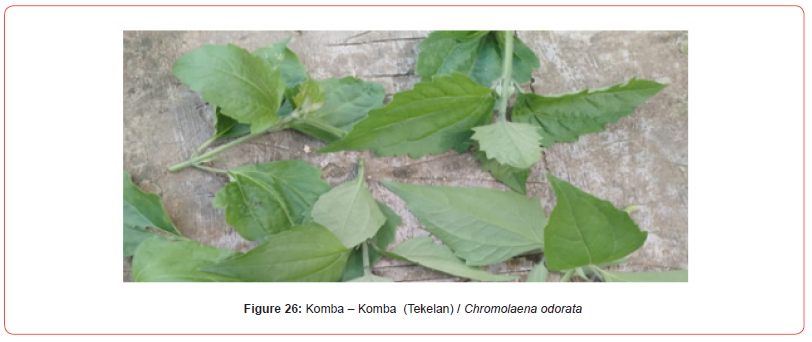
Komba-komba is one type of wild plant that is easy to grow in the tropics. Plants are very easy to find in forest areas and in plantation areas. This plant has many properties in treating various diseases. Commonly treated diseases such as wounds, quickly ripen ulcers and internal diseases. Muna people claim that tembelekan and Komba-komba leaves can heal wounds by kneading or mashing. Tembelekan plants can cure various kinds of diseases both roots, leaves, flowers, and fruits by boiling the roots, mashed, roasted and soaked into drinking water. The wound treatment process using komba-komba leaves and tembelekan attached to the wound aims to make the water on the leaves that have been smoothed can seep into the wound so that the wound becomes dry and heals quickly.
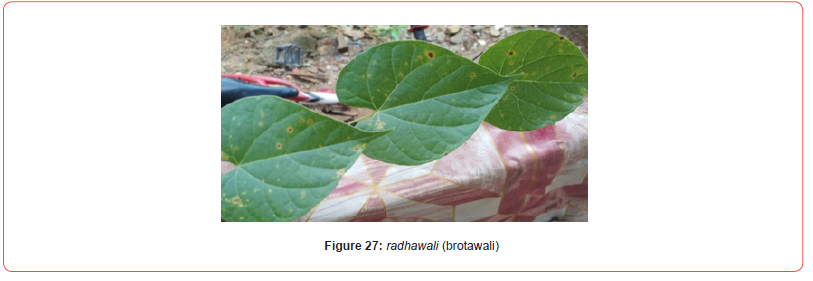
Radhawali plants have astem height of 2.5 m or more. The stem is as big as a little finger, tightly nodulated, bitter taste. Single leaves, located on certain nodes, are heart-shaped with tapered tips, flat leaf edges, fingered leaf bones, light green in color and can cure diabetes. How to use Brotowali stems are cut into 10 cm ± pieces then boiled with 2 cups of water and until the result is 1 glass then drunk 1 time 1 day for 2 days. Although this plant has a very bitter taste, its health benefits have been proven since time immemorial “since the time of our ancestors”.

Sirikaea is a versatile plant, the fruit is edible and can be used as an ingredient in traditional medicine that treats various types of disease. In Muna society, this plant is more widely used to treat heat illness for children and other diseases [13]. The trick is that the soursop leaves are washed thoroughly then boiled to boil, and cool and then strain, soursop leaves are washed thoroughly and then attached to the painful limbs. Soursop leaves are also believed to treat high blood pressure and pain in the limbs by pasting and accompanied by mantras. Seeds are used to cope with weak digestion, intestinal worms, and deadly head lice and insects. Young fruits are used to treat diarrhea, acute dysentery, and digestive disorders (atonic dyspepsia). The root is used to treat constipation, acute dysentery, mental depression, and back pain. The bark is used to treat diarrhea, dysentery, and bleeding wounds.
The saha plant is one plant that has many benefits for humans. This plant is widely cultivated by the community both in the yard and in agricultural gardens. In general, the leaves of chili plants are not used by the public after picking chili fruits. Chili leaves are used as a natural stomach spasm and without spending money is to use herbal medicine made from the collision of several chili leaves that have been brewed with warm or hot water., and the boiled water is used as a traditional medicine to treat stomach spasms. While as an external medicine, chili leaves have become a traditional herb down and down to treat infections on the skin, wounds and diarrhea. In the Muna community, chili leaves are used to treat ulcer maturation by mixing with a little water and kneading or kneading until smooth. After that applied boil diarae on the limbs.
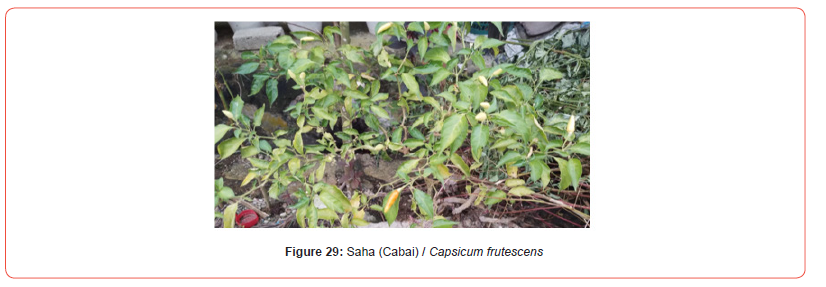
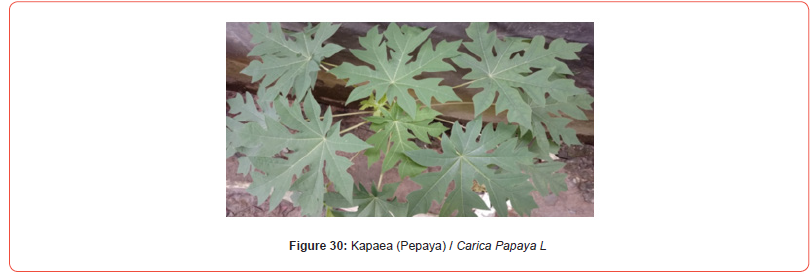
Kapaea is one of the fruit commodities that has many functions and benefits in it both as a food or vegetable ingredient and as a traditional medicine. Papaya plants can also be used as traditional medicine for the Muna community. People can use papaya plants as medicine, both leaves, seeds, sap, flowers and fruits. Papaya plant organs that can be used for medicine and for other uses are seeds, leaves, fruits, sap and flowers. Papaya seeds are used for deworming [14]. Papaya seeds are efficacious to prevent and eradicate worms and other parasites in the stomach. Papaya leaves can be used as a blood pressure controller. Papaya fruit can also be used for cooking, fruit consumption, snacks and drinks. Papaya fruit has many benefits, both young papaya and ripe papaya. Raw papaya fruit can be used to facilitate breast milk, overcome constipation, menstrual disorders, and stomach disorders. Muna people use sap as a remedy for burns and itchy itching on the skin (as an external medicine). Papaya sap is applied to skin that has burns or itching. The sap before applying is cleaned first so that infection does not occur. Papaya sap can also be used to cure acne prone skin, in addition, Muna people also consume papaya flowers to treat cholesterol disease.
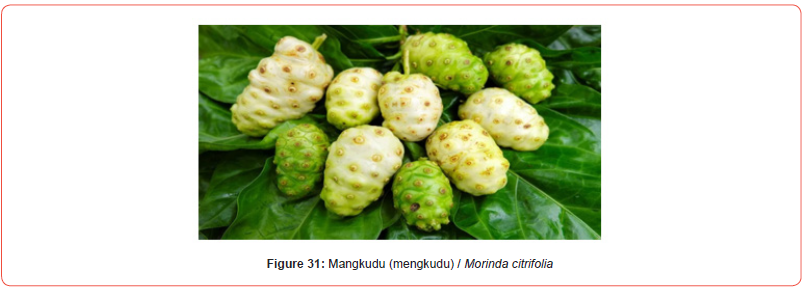
Bhangkudu is a type of tropical plant that is easily found in a certain environment. This plant has been used as herbal medicine to treat various types of diseases. For the Muna people, noni plants are used to treat jaundice, diabetes, high blood pressure/hypertension, headaches, and stomach. The trick is that noni fruit is grated then filtered and drunk water. Since long ago noni fruit was widely used for herbal medicine. Among them are to treat arthritis, diabetes, high blood pressure (hypertension), headaches, heart disease, stomach ulcers, arteriosclerosis, and blood vessel problems (Ayanblu F et al. 2006).
Conclusion
Based on the results of the study it can be concluded that as follows:
The types of plants used by the Muna community as traditional medicine materials obtained in the study were 30 types of plants, namely Ntanga - Ntanga (Distance), Bumalaka (Guava), Sambiloto (Sambiloto), Tongkoea (Pulai), Gamala (Gamal), Padamalala (Lemongrass), Lakora (Jukut Peendul), Kansilala, Kapati - Pati (Kebo Citation), Kamena - Mena (Miss Flower), Katola, Broken Shard and Cat Whiskers, Libho (wars), Gersen (Gerseni), bulumembe (Sadugari), Kabu – Kaburu, Kadhawa (Kapuk/Randu), Katabha-tabhako (sembung), Puno (Ruku-Ruku), Loghi (Ginger), Kuni (Turmeric), Patiwala (Tembelakan), Kalima-lamano tooke (panabelut), Kambo-mbote (Ciplukan), Bhanggai (Moringa), Komba – Komba (Tekelan), Radhawali (Brotawali), Sirikaea (Sirikaya), Saha (Chili), Kapaea (Papaya) and Mangkudu (noni).
The procedure for processing and utilizing plants as traditional medicine is carried out in several ways, namely by boiling and drinking, pounding and then smearing/pasting, shredding and drunk, chewing then blowing, cutting, and dripping. However, Muna people more often use potions by boiling and then drinking/ drinking to patients or sick people. Then, the benefits of plants in traditional medicine are to treat high blood pressure, to treat reduce pain in organs, to heal wrong wounds, to treat asthma, to treat dangerous diseases, to treat fever, to treat external wounds, to treat diarrhea, to treat trachoma, to treat itching in the skin and so on.
Acknowledgement
Thanks are expressed to the Rector of Halu Oleo University, The Dean of the Faculty of Cultural Sciences, Halu Oleo University for providing the opportunity and funding support through the internal research funds of the Faculty of Cultural Sciences, so that with this opportunity and funding the research can be carried out well and can be published in an international journal.
Thanks are also expressed to the West Muna Regency government and all of society, especially to the informants who have provided the convenience and facilities needed for research, as well as information related to the data needed in this research.
Conflict of Interest
There is no conflict of interest.
References
- Daulay (2011) Pengetahuan Tradisional Konsep Dasar Hukum dan Praktknya.
- Darnaedi, S.Y (1998) Perspektif dan kajian etnobotani tumbuhan obat orang Rejang. Tesis. Program studi Biologi. Program Pascasarjana Universitas Indonesia, Depok, pp. 137.
- Zuhud, E A M dan Haryanto (1994) Pelestarian Pemanfaatan Keanekaragaman Tumbuhan Obat Hutan Tropika Indonesia. Kerja Sama Jurusan Konservasi Sumberdaya Hutan IPB dan Lembaga Alam Tropika Indonesia (LATIN): Bogor.
- Hakim L (2014) Etnobotani dan Manajemen Kebun Pekarangan Rumah. Ketahanan Pangan: Kesehatan Dan Agrowisata. Malang: Penerbit Selaras.
- Kasmawati H, Ihsan S, Suprianti R (2019) Kajian Etnomedisin Tumbuhan Obat Tradisional Suku.
- Mamahani A F, Simbala H E I, Saroyo (2016) Etnobotani Tumbuhan Obat Masyarakat Subetnis Tonsawang di Kabupaten Minahasa Tenggara Provinsi Sulawesi Utara. PHARMACON: Jurnla Ilmiah Farmasi 5(2) :205-212.
- Pei SJ (2013) Ethnobotany and Sustainable Use of Biodiversity Plant and Diversity Resources 35(4) :401-406.
- Purwanto Y (2002) Studi etnomedisinal dan fitofarmakope tradisional Indonesia. Prosid
- Sudarmono (2018) Etnomedisin Masyarakat Warsamdin, Kepualauan Raja Ampat Papua. Proceeding of Biology Education 2(1): 50-58.
- Sudarsono, Didik G, Wahyuono S, Donatus I, Purnomo (2002) Tumbuhan Obat II (Hasil Penelitian, Sifat-sifat dan Penggunaan). Pusat Penelitian Obat Tradisional, UGM: Jakarta, pp. 69-71.
- Sukmawati N, Yuniati E, Pitopang R (2013) Studi Etnobotani Tumbuhan Obat Pada Masyarakat Suku Kaili Rai di Desa Toga Kecamatan Ampibabo Kabupaten Parigi Moutong Sulawesi Tengah. Biocelebes 7(2): 9-14.
- Tjitrosoepomo, Gembong (1988) Taksonomi tumbuhan (Spermathopyta). Yogyakarta: Gajah Mada University Press.
- Wasito, Hendri (2011) Obat Tradisonal Kekayaan Indonesia. Graha Ilmu: Banyuwangi
- Zein U (2005) Pemanfaatan Tumbuhan Obat Dalam Upaya Pemeliharaan Kesehatan. Fakultas Kedokteran Divisi Penyakit Tropik dan Infeksi. Bagian Ilmu Penyakit Dalam. Universitas Sumatera Utara.
-
Rahmat Sewa Suraya*, Hardin, La Ode Muhammad Sardin, Agus Rihu and La Ode Muhammad Detif Rahim. Knowledge of Ethnobotany as Traditional Medicine Muna Community in West Muna Regency. Sci J Research & Rev. 4(1): 2023. SJRR.MS.ID.000577.
UN General, Spatial planning, Lighting, Food storage, Garbage disposal
-

This work is licensed under a Creative Commons Attribution-NonCommercial 4.0 International License.






